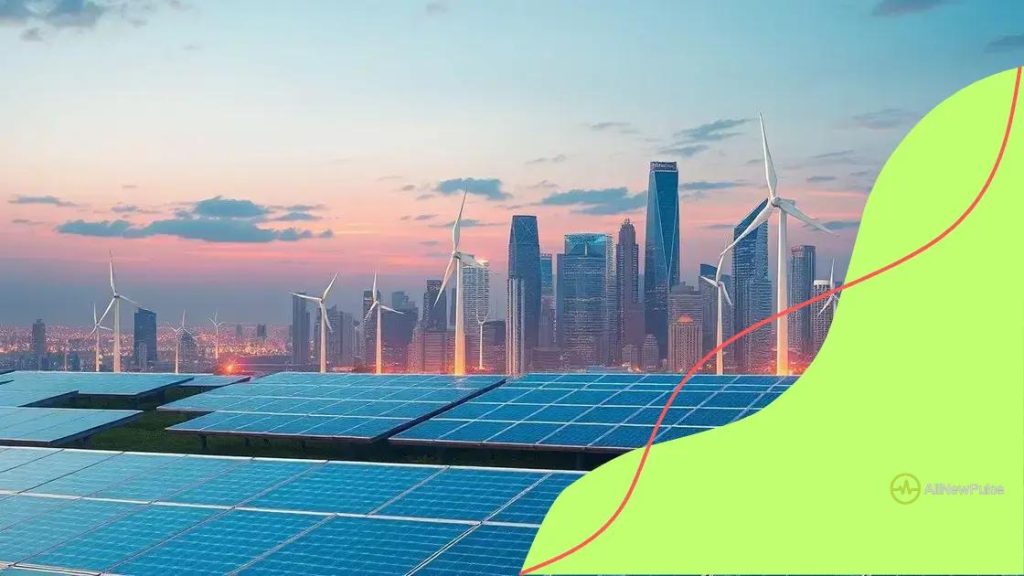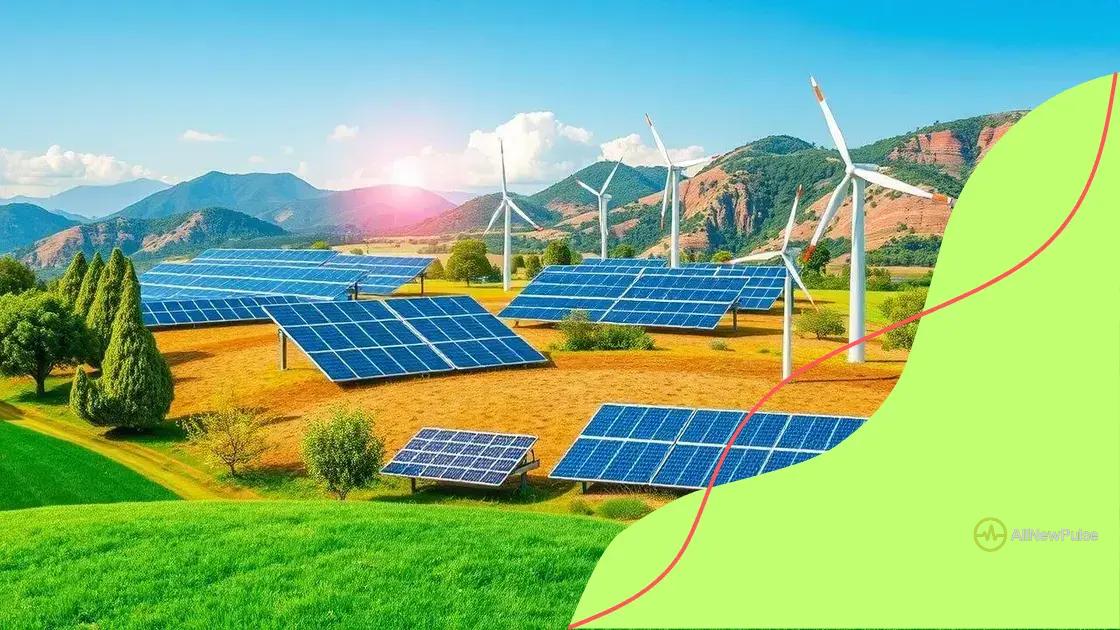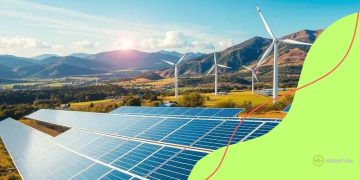The future of energy production and consumption is here

The future of energy production and consumption relies on renewable sources and smart technologies to enhance efficiency, reduce pollution, and overcome challenges like intermittency through innovative solutions and community engagement.
The future of energy production and consumption is evolving rapidly, prompting us to rethink how we generate and utilize energy. With new technologies and innovative solutions emerging, have you ever wondered what tomorrow’s energy landscape will look like?
Current trends in energy production
Today, understanding the current trends in energy production is vital for developing a sustainable future. With innovations emerging daily, we are seeing remarkable changes in how we source energy.
Shift Towards Renewables
One of the most significant trends is the shift towards renewable energy sources. Governments and companies are investing in technologies that harness wind, solar, and hydro power. These sources are not only more sustainable but also help reduce carbon emissions.
Technological Innovations
Advancements in technology are shaping how we produce energy. For instance, energy storage solutions, such as batteries, are improving efficiency and reliability. This allows energy generated during peak production times, like midday solar power, to be used later, ensuring a steady supply.
- Increased deployment of solar panels
- Enhancements in wind turbine efficiency
- Development of smart grids
- Growth of bioenergy production
Another trend is the rise of smart grids. These grids utilize digital technology to monitor and manage the transport of electricity. This innovation leads to a more resilient energy infrastructure and better energy management.
Decentralized Energy Systems
Decentralized energy systems are gaining traction as more individuals and communities opt for off-grid solutions. This allows them to produce their own energy, often from renewable sources. It not only reduces dependence on traditional energy providers but also promotes energy independence.
Lastly, we should highlight the importance of public awareness and involvement. As communities become more educated about energy issues, they are more likely to support sustainable practices and demand action from decision-makers. This increased awareness drives change and pushes for regulatory reforms that prioritize cleaner energy solutions.
Innovations shaping future energy consumption
Innovations are crucial for shaping future energy consumption. As technology advances, our energy usage becomes more efficient and sustainable.
Smart Home Technologies
One major innovation is the rise of smart home technologies. Smart devices, like thermostats and lighting systems, allow homeowners to manage their energy usage effectively. For example, smart thermostats learn your schedule and adjust heating or cooling accordingly. This not only saves energy but also reduces costs.
Energy-Efficient Appliances
The development of energy-efficient appliances is another significant trend. Appliances that consume less energy help households lower their electricity bills. Many of these devices now come with Energy Star ratings, which indicate better efficiency. Using energy-efficient products is a practical way to reduce your carbon footprint.
- Smart thermostats automatically adjust temperatures
- LED lighting consumes less power
- Energy-efficient refrigerators and washers
- Smart power strips manage energy usage
In addition to smart appliances, renewable energy integration is reshaping consumption patterns. For instance, solar panels enable homeowners to generate their own power. This leads to reduced reliance on the grid and promotes a sustainable lifestyle.
Electric Vehicles
Another innovation influencing energy use is the rise of electric vehicles (EVs). These vehicles offer a cleaner alternative to traditional gasoline-powered cars. With advances in battery technology, EVs now have greater ranges and shorter charging times. This makes them more appealing to consumers, encouraging a shift away from fossil fuels.
As more people adopt EVs, the demand for charging infrastructure increases. Cities and businesses are responding by installing charging stations, further supporting this shift. The combination of smart technology and renewable energy sources is creating a new landscape for energy consumption.
The impact of renewable energy sources

The impact of renewable energy sources on our environment and economy is profound. These energy sources, such as solar, wind, and hydro, are changing how we think about energy production and consumption.
Environmental Benefits
First, renewable energy significantly reduces greenhouse gas emissions. By replacing fossil fuels, we can lower air pollution and combat climate change. For example, wind turbines and solar panels emit no direct emissions, making them cleaner alternatives.
Economic Advantages
Additionally, renewable energy promotes economic growth. New jobs are created in manufacturing, installation, and maintenance of renewable energy technologies. For instance, the solar industry alone has generated thousands of jobs in recent years, providing employment opportunities across various skill levels.
- Job creation in local communities
- Reduced energy costs for consumers
- Increased energy independence
- Boost in investment in infrastructure
Moreover, as technology advances, the costs associated with renewable energy have plummeted. Solar and wind energy have become some of the most economical energy sources available. This affordability allows more people to access clean energy and encourages further adoption.
Social Impacts
The social impact of renewable energy can also be seen in rural communities. Many renewable projects are located in these areas, providing income and infrastructure improvements. People benefit from better local services, schools, and health care as these projects often lead to increased tax revenues.
Finally, with the shift to renewable energy, there is a growing awareness of sustainability and conservation. Communities are beginning to embrace greener practices, leading to a collective effort to preserve our planet for future generations.
Smart technology in energy management
Smart technology is transforming energy management in significant ways. By using advanced systems and devices, we can optimize our energy consumption and reduce waste.
Energy Monitoring Systems
One of the key components of smart energy management is energy monitoring systems. These systems track electricity usage in real-time, allowing consumers to see how much energy they are using. Knowing this information helps people make smarter choices about their energy consumption.
Smart Meters
Smart meters are another important innovation. They provide instant feedback on energy use, replacing traditional meters. With smart meters, homeowners can adjust their usage during peak times, which can lead to lower energy bills.
- Real-time data on energy consumption
- Alerts for unusual usage patterns
- Improved billing accuracy
- Ability to manage energy use remotely
Automation is also a big part of smart technology in energy management. Smart home devices can automatically adjust appliances based on time of day or energy prices. For instance, washing machines and dishwashers can run during hours when energy is cheaper, saving money for users.
Integration with Renewable Energy
Moreover, smart technology enables better integration of renewable energy sources. Homes equipped with solar panels can connect to smart systems that track energy production and consumption. This coordination ensures that energy generated from the sun is used efficiently.
In addition, smart grids play a vital role in managing electricity distribution. They enhance reliability and efficiency by communicating information between utilities and consumers. This helps balance energy supply and demand more effectively, leading to a more stable energy future.
Challenges and solutions for sustainable energy
Addressing the challenges and solutions for sustainable energy is critical as we move toward a greener future. Although renewable energy has many benefits, there are obstacles to overcome.
Challenge: Intermittency of Renewable Sources
One significant challenge is the intermittency of renewable energy sources like solar and wind. These sources depend on weather conditions, making energy generation variable. For instance, solar power is not generated at night, and wind energy relies on breezy conditions.
Solution: Energy Storage Technologies
To tackle this issue, energy storage technologies are becoming essential. Innovations in battery technology allow us to store excess energy produced during peak times. This stored energy can then be used when production is low, ensuring a reliable energy supply.
- Development of advanced lithium-ion batteries
- Use of pumped hydro storage systems
- Exploration of emerging technologies like solid-state batteries
- Integration of flywheel energy storage
Another challenge lies in the existing energy infrastructure. Many systems were designed for fossil fuels and may not support renewable energy integration effectively. This can lead to inefficiencies and higher operational costs.
Solution: Upgrading Infrastructure
Upgrading the grid to accommodate renewable sources is a proposed solution. Smart grids can manage energy flow more effectively, enhancing resilience and efficiency. By investing in modern infrastructure, we can better utilize renewable energy and reduce dependence on traditional sources.
Financial barriers also pose a challenge. Initial investments in renewable energy projects can be high, deterring individuals and businesses from making the switch. However, various financing options are becoming available.
Solution: Innovative Financing Models
Innovative financing models, like community solar programs and power purchase agreements, are making it easier for consumers to access renewable energy. By sharing the costs and benefits, more people can participate in the transition to sustainable energy.
With these challenges and solutions in mind, it’s clear that while obstacles exist, there are also numerous paths forward to create a more sustainable energy future for everyone.
FAQ – Frequently Asked Questions about Sustainable Energy
What are the main benefits of renewable energy?
Renewable energy reduces pollution, decreases reliance on fossil fuels, and promotes job creation in new energy sectors.
How can energy storage technologies help with renewable energy?
Energy storage technologies allow excess energy generated during peak times to be saved and used when production is low, ensuring reliable power supply.
What challenges do we face in transitioning to sustainable energy?
Challenges include the intermittency of renewable sources, upgrading existing infrastructure, and financial barriers for individuals and businesses.
How can communities encourage the use of renewable energy?
Communities can promote renewable energy by supporting local projects, implementing incentives, and educating citizens about the benefits of sustainability.





